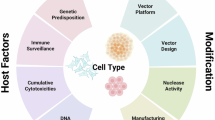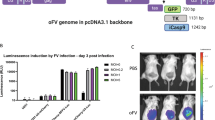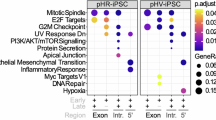Abstract
The successful application of cancer gene therapy has been hampered by the low efficiency of in vivo gene delivery by currently used replication-defective vectors. Accordingly, considerable efforts are now being directed toward development and use of vectors capable of replicating in cancer cells. However, for replicating retroviruses, insertion of additional reading frames into the viral genome often resulted in the generation of unstable viruses. Here, we report a novel concept for the generation of replication-competent murine leukemia virus (MLV) vectors capable of mediating the secretion of soluble therapeutic proteins from infected cells. As a proof of principle, we inserted transgene regions encoding either a single-chain variable region fragment (scFv), here, the laminin-specific L36-scFv, or the T-cell-specific 7A5-scFv, or the cytokine GM-CSF into the MLV envelope (env) gene after +1 codon of the envelope (Env) protein, followed by a sequence specifying a furin protease cleavage site. The resulting viruses, termed L36-furin-A, 7A5-furin-A and GMCSF-furin-Mo, respectively, infected a variety of human cell lines, including HMEC-1 (endothelial), A301 (lymphoid), MDA-MB231 and MDA-MB468 (breast cancer) and HT1080 (fibrosarcoma) cells. Western blot analysis of conditioned culture medium from HT1080 cells infected by replicating L36-furin A, as an example, revealed that more than 90% of the Env fusion protein molecules were indeed intracellularly cleaved. After 5 days of infection, up to 3–4 μg/ml of soluble L36-scFv accumulated in the supernatant of HT1080 cells. The eukaryotically produced L36-scFv and 7A5-scFv were able to recognize their native antigens with high avidity, as assessed by ELISA and flow cytometry. Furthermore, the replicating viruses were genetically stable for more than 12 cell passages. In conclusion, a new generation of replication-competent retroviral vectors capable of mediating long-term and efficient secretion of therapeutic proteins suitable for cancer therapy was generated.
This is a preview of subscription content, access via your institution
Access options
Subscribe to this journal
Receive 12 print issues and online access
$259.00 per year
only $21.58 per issue
Buy this article
- Purchase on SpringerLink
- Instant access to full article PDF
Prices may be subject to local taxes which are calculated during checkout





Similar content being viewed by others
References
Roth JA, Cristiano RJ . Gene therapy for cancer: what have we done and where are we going? J Natl Cancer Inst. 1997;89:21–39.
Vile RG, Russell SJ, Lemoine NR . Cancer gene therapy: hard lessons and new courses. Gene Therapy. 2000;7:2–8.
Ram Z, Culver KW, Oshiro EM, et al. Therapy of malignant brain tumors by intratumoral implantation of retroviral vector-producing cells. Nat Med. 1997;3:1354–1361.
Kruse CA, Roper MD, Kleinschmidt-DeMasters BK, et al. Purified herpes simplex thymidine kinase retrovector particles. I. In vitro characterization, in situ transduction efficiency, and histopathological analyses of gene therapy-treated brain tumors. Cancer Gene Ther. 1997;4:118–128.
Russell SJ . Replicating vectors for gene therapy of cancer: risks, limitations and prospects. Eur J Cancer. 1994;30A:1165–1171.
Yoon TK, Shichinohe T, Laquerre S, Kasahara N . Selectively replicating adenoviruses for oncolytic therapy. Curr Cancer Drug Targets. 2001;1:85–107.
Mullen JT, Tanabe KK . Viral oncolysis. The Oncologist. 2002;7:106–119.
Liu BL, Robinson M, Han ZQ, et al. ICP34.5 deleted herpes simplex virus with enhanced oncolytic, immune stimulating, and anti-tumour properties. Gene Therapy. 2003;10:292–303.
Vile RG, Sunassee K, Diaz RM . Strategies for achieving multiple layers of selectivity in gene therapy. Mol Med Today. 1998;4:84–92.
Peng KW, Russell SJ . Viral vector targeting. Curr Opin Biotechnol. 1999;10:454–457.
Spencer DM . Developments in suicide genes for preclinical and clinical applications. Curr Opin Mol Ther. 2000;2:433–440.
Bansal K, Engelhard HH . Gene therapy for brain tumors. Curr Oncol Rep. 2000;2:463–472.
O'Reilly MS, Boehm T, Shing Y, et al. Endostatin: an endogenous inhibitor of angiogenesis and tumor growth. Cell. 1997;88:277–285.
Regulier E, Paul S, Marigliano M, et al. Adenovirus-mediated delivery of antiangiogenic genes as an antitumor approach. Cancer Gene Ther. 2001;8:45–54.
Scappaticci FA, Smith R, Pathak A, et al. Combination angiostatin and endostatin gene transfer induces synergistic antiangiogenic activity in vitro and antitumor efficacy in leukemia and solid tumors in mice. Mol Ther. 2001;3:186–196.
Li H, Lindenmeyer F, Grenet C, et al. AdTIMP-2 inhibits tumor growth, angiogenesis, and metastasis, and prolongs survival in mice. Hum Gene Ther. 2001;12:515–526.
Sanz L, Kristensen P, Blanco B, et al. Single-chain antibody-based gene therapy: inhibition of tumor growth by in situ production of phage-derived human antibody fragments blocking functionally active sites of cell-associated matrices. Gene Therapy. 2002;9:1049–1053.
Dillon PJ, Lenz J, Rosen CA . Construction of a replication-competent murine retrovirus vector expressing the human immunodeficiency virus type 1 tat transactivator protein. J Virol. 1991;65:4490–4493.
Reik W, Weiher H, Jaenisch R . Replication-competent Moloney murine leukemia virus carrying a bacterial suppressor tRNA gene: selective cloning of proviral and flanking host sequences. Proc Natl Acad Sci USA. 1985;82:1141–1145.
Stuhlmann H, Jaenisch R, Mulligan RC . Construction and properties of replication-competent murine retroviral vectors encoding methotrexate resistance. Mol Cell Biol. 1989;9:100–108.
Buchholz CJ, Peng KW, Morling FJ, et al. In vivo selection of protease cleavage sites from retrovirus display libraries. Nat Biotechnol. 1998;16:951–954.
Nakayama K . Furin: a mammalian subtilisin/Kex2p-like endoprotease involved in processing of a wide variety of precursor proteins. Biochem J. 1997;327:625–635.
Sanz L, Kristensen P, Russell SJ, Ramirez Garcia JR, Alvarez-Vallina L . Generation and characterization of recombinant human antibodies specific for native laminin epitopes: potential application in cancer therapy. Cancer Immunol Immunother. 2001;50:557–565.
Engelstadter M, Bobkova M, Baier M, et al. Targeting human T cells by retroviral vectors displaying antibody domains selected from a phage display library. Hum Gene Ther. 2000;11:293–303.
Schneider RM, Medvedovska Y, Hartl I, et al. Directed evolution of retroviruses activatable by tumor-associated matrix metalloproteases. Gene Therapy. 2003;10:1370–1380.
Sorokin L, Girg W, Gopfert T, Hallmann R, Deutzmann R . Expression of novel 400-kDa laminin chains by mouse and bovine endothelial cells. Eur J Biochem. 1994;223:603–610.
Ekblom M, Falk M, Salmivirta K, Durbeej M, Ekblom P . Laminin isoforms and epithelial development. Ann N Y Acad Sci. 1998;857:194–211.
Miosge N . The ultrastructural composition of basement membranes in vivo. Histol Histopathol. 2001;16:1239–1248.
Jespersen T, Duch M, Carrasco ML, Warming S, Pedersen FS . Expression of heterologous genes from an IRES translational cassette in replication competent murine leukemia virus vectors. Gene. 1999;239:227–235.
Miller AD . Development and applications of retroviral vectors. In: Coffin JM, Hughes HH, Varmus HE, eds. Retroviruses. Cold Spring Harbor, NY: Cold Spring Harbor Laboratory Press; 1997: 437–474.
Logg CR, Tai CK, Logg A, Anderson WF, Kasahara N . A uniquely stable replication-competent retrovirus vector achieves efficient gene delivery in vitro and in solid tumors. Hum Gene Ther. 2001;12:921–932.
Logg CR, Logg A, Tai CK, Cannon PM, Kasahara N . Genomic stability of murine leukemia viruses containing insertions at the Env-3′ untranslated region boundary. J Virol. 2001;75:6989–6998.
Wang WJ, Tai C-K, Kasahara N, Chen TC . Highly efficient and tumor-restricted gene transfer to malignant gliomas by replication-competent retroviral vectors. Hum Gene Ther. 2003;14:117–127.
Liu YC, Kawagishi M, Mikayama T, et al. Processing of a fusion protein by endoprotease in COS-1 cells for secretion of mature peptide by using a chimeric expression vector. Proc Natl Acad Sci USA. 1993;90:8957–8961.
Groskreutz DJ, Sliwkowski MX, Gorman CM . Genetically engineered proinsulin constitutively processed and secreted as mature, active insulin. J Biol Chem. 1994;269:6241–6245.
Gaken J, Jiang J, Daniel K, et al. Fusagene vectors: a novel strategy for the expression of multiple genes from a single cistron. Gene Therapy. 2000;7:1979–1985.
Sandrin V, Russell SJ, Cosset FL . Targeting retroviral and lentiviral vectors. Curr Top Microbiol Immunol. 2003;281:137–178.
Murray L, Luens K, Tushinski R, et al. Optimization of retroviral gene transduction of mobilized primitive hematopoietic progenitors by using thrombopoietin, Flt3, and Kit ligands and RetroNectin culture. Hum Gene Ther. 1999;10:1743–1752.
Donahue RE, Kessler SW, Bodine D, et al. Helper virus induced T cell lymphoma in nonhuman primates after retroviral mediated gene transfer. J Exp Med. 1992;176:1125–1135.
Marshall E . Clinical research. Gene therapy a suspect in leukemia-like disease. Science. 2002;298:34–35.
Nilson BH, Morling FJ, Cosset FL, Russell SJ . Targeting of retroviral vectors through protease-substrate interactions. Gene Therapy. 1996;3:280–286.
Logg CR, Logg A, Matusik RJ, Bochner BH, Kasahara N . Tissue-specific transcriptional targeting of a replication-competent retroviral vector. J Virol. 2002;76:12783–12791.
Diaz RM, Eisen T, Hart IR, et al. Exchange of viral promoter/enhancer elements with heterologous regulatory sequences generates targeted hybrid long terminal repeat vectors for gene therapy of melanoma. J Virol. 1998;72:789–795.
Jager U, Zhao Y, Porter CD . Endothelial cell-specific transcriptional targeting from a hybrid long terminal repeat retrovirus vector containing human prepro-endothelin-1 promoter sequences. J Virol. 1999;73:9702–9709.
Acknowledgements
This work was supported by grant 2002.067.1 of the Wilhelm-Sander-Stiftung to CJB and KC and from the Ministerio de Ciencia y Tecnología (grant BIO2001-0385) and the 5th framework of the European Community (Grant EC QLK3-CT-1999-00386) to L Á-V.
Author information
Authors and Affiliations
Corresponding author
Rights and permissions
About this article
Cite this article
Finger, C., Sun, Y., Sanz, L. et al. Replicating retroviral vectors mediating continuous production and secretion of therapeutic gene products from cancer cells. Cancer Gene Ther 12, 464–474 (2005). https://doi.org/10.1038/sj.cgt.7700805
Received:
Published:
Issue date:
DOI: https://doi.org/10.1038/sj.cgt.7700805
Keywords
This article is cited by
-
Influence of vector design and host cell on the mechanism of recombination and emergence of mutant subpopulations of replicating retroviral vectors
BMC Molecular Biology (2009)
-
Cell entry targeting restricts biodistribution of replication-competent retroviruses to tumour tissue
Gene Therapy (2008)
-
Chronic gene delivery of interferon-inducible protein 10 through replication-competent retrovirus vectors suppresses tumor growth
Cancer Gene Therapy (2005)



